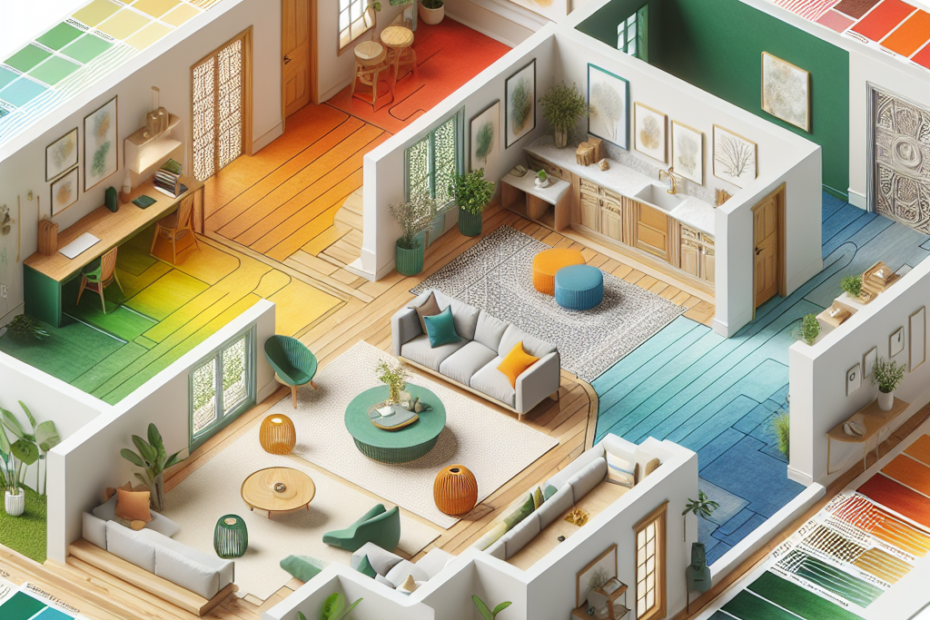How to Use Color to Define Different Spaces in Open Layouts
Open layouts have become a popular choice in modern homes and offices. They provide a spacious and airy environment but can sometimes lack clear boundaries between different functional areas. This is where the strategic use of color comes into play. By leveraging the power of color for space definition, one can create visually distinct areas within an open layout while maintaining a cohesive overall look.
Understanding the Psychology of Color
Before jumping into the application of colors, it’s crucial to understand how different hues can affect moods and behaviors. According to a study by the University of Texas, the colors you choose for a space can influence people’s emotions and productivity levels. For example:
- Blue: Promotes calm and focus, making it ideal for workspaces.
- Red: Energizes and stimulates, suitable for social areas like living rooms.
- Yellow: Invokes happiness and creativity, perfect for kitchens and art spaces.
- Green: Balances and refreshes, great for relaxation zones.
Using Color to Define Spaces
Here are some effective strategies for using color to define different areas within an open layout:
Accent Walls
One of the simplest ways to use color for space definition is through accent walls. An accent wall in a distinct color can delineate a functional area within an open space. For example, painting the wall behind a sofa in a rich, warm hue can define a cozy living room area.
Color Blocking
Color blocking involves using two or more contrasting colors in large, solid sections. This method can create a modern and sophisticated look while clearly defining different spaces.
Furniture and Accessories
Color coordination doesn’t need to be limited to walls. Using furniture and accessories in different colors can also designate various areas. For instance, a red dining table with matching cushions can set apart the dining area from the rest of the room.
Flooring and Rugs
Changing the flooring or adding rugs can also define spaces. A wooden floor for the kitchen area and a carpet for the living area can clearly differentiate these zones even within an open layout.
Statistics on Open Layouts and Color Usage
According to a survey by HomeAdvisor, 70% of homeowners prefer open layouts for their homes, citing reasons like more natural light and improved family interaction. Furthermore, a Color Psychology study found that 62% of participants feel more productive in color-coordinated spaces (source, source).
| Color | Emotional Response | Recommended Space |
|---|---|---|
| Blue | Calm, Focus | Workspace |
| Red | Energized, Stimulated | Living Room |
| Yellow | Happy, Creative | Kitchen |
| Green | Balanced, Refreshed | Relaxation Zone |
Practical Tips for Beginners
If they are new to using color for space definition, start small. Experiment with cushions, throws, and small pieces of furniture before committing to painting walls or large decor items. Consider using a color wheel to find contrasting or complementary colors that work well together for a balanced look.
Lighting Matters
The way colors appear can be affected by the lighting in the room. Natural daylight reveals the truest version of colors, while artificial lighting can alter their appearance.
Consistency is Key
While it is important to define different areas, the overall design should still feel cohesive. Choose colors from the same palette or complementary shades to ensure a smooth visual flow.
Key Takeaways
- Color psychology can significantly affect mood and functionality.
- Accent walls, color blocking, and using colorful furniture and accessories are effective strategies.
- Changing flooring materials can further define spaces within an open layout.
- Surveys suggest open layouts are popular, and strategically colored spaces boost productivity.
- Start with small color changes and consider lighting and consistency for best results.
Frequently Asked Questions (FAQ)
1. What is the best color for a home office in an open layout?
Blue is often considered the best color for a home office as it promotes calm and focus.
2. How can they make their living area stand out in an open layout?
Painting an accent wall in a warm hue like red or using colorful furniture can help define a living area.
3. Should they be concerned about the lighting when choosing colors?
Yes, the type of lighting can significantly affect how colors appear. Always test colors with both natural and artificial light.
4. Can they use more than two colors to define spaces?
Absolutely. However, it is recommended to ensure the chosen colors are complementary to maintain a cohesive look.
5. What if they want to change the colors later?
Start with smaller items like cushions or throws before making significant changes like painting walls. This way, they can easily switch colors if they change their mind later.
